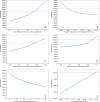Cost-effectiveness of Intraoperative MRI for Treatment of High-Grade Gliomas
- PMID: 30912721
- PMCID: PMC6543900
- DOI: 10.1148/radiol.2019182095
Cost-effectiveness of Intraoperative MRI for Treatment of High-Grade Gliomas
Abstract
Background Intraoperative MRI has been shown to improve gross-total resection of high-grade glioma. However, to the knowledge of the authors, the cost-effectiveness of intraoperative MRI has not been established. Purpose To construct a clinical decision analysis model for assessing intraoperative MRI in the treatment of high-grade glioma. Materials and Methods An integrated five-state microsimulation model was constructed to follow patients with high-grade glioma. One-hundred-thousand patients treated with intraoperative MRI were compared with 100 000 patients who were treated without intraoperative MRI from initial resection and debulking until death (median age at initial resection, 55 years). After the operation and treatment of complications, patients existed in one of three health states: progression-free survival (PFS), progressive disease, or dead. Patients with recurrence were offered up to two repeated resections. PFS, valuation of health states (utility values), probabilities, and costs were obtained from randomized controlled trials whenever possible. Otherwise, national databases, registries, and nonrandomized trials were used. Uncertainty in model inputs was assessed by using deterministic and probabilistic sensitivity analyses. A health care perspective was used for this analysis. A willingness-to-pay threshold of $100 000 per quality-adjusted life year (QALY) gained was used to determine cost efficacy. Results Intraoperative MRI yielded an incremental benefit of 0.18 QALYs (1.34 QALYs with intraoperative MRI vs 1.16 QALYs without) at an incremental cost of $13 447 ($176 460 with intraoperative MRI vs $163 013 without) in microsimulation modeling, resulting in an incremental cost-effectiveness ratio of $76 442 per QALY. Because of parameter distributions, probabilistic sensitivity analysis demonstrated that intraoperative MRI had a 99.5% chance of cost-effectiveness at a willingness-to-pay threshold of $100 000 per QALY. Conclusion Intraoperative MRI is likely to be a cost-effective modality in the treatment of high-grade glioma. © RSNA, 2019 Online supplemental material is available for this article. See also the editorial by Bettmann in this issue.
Figures





Comment in
-
Intraoperative MRI for Treatment of High-Grade Glioma: Is It Cost-effective?Radiology. 2019 Jun;291(3):698-699. doi: 10.1148/radiol.2019190337. Epub 2019 Mar 26. Radiology. 2019. PMID: 30917295 No abstract available.
References
-
- Johannesen TB, Langmark F, Lote K. Cause of death and long-term survival in patients with neuro-epithelial brain tumours: a population-based study. Eur J Cancer 2003;39(16):2355–2363. - PubMed
-
- Trifiletti DM, Alonso C, Grover S, Fadul CE, Sheehan JP, Showalter TN. Prognostic implications of extent of resection in glioblastoma: analysis from a large database. World Neurosurg 2017;103:330–340. - PubMed
Publication types
MeSH terms
Grants and funding
LinkOut - more resources
Full Text Sources
Medical

